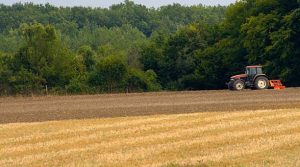Imagine a vast field, not as a canvas for haphazard seed scattering, but as a symphony of precision placement. Modern seeding equipment, especially those by industry leader John Deere, transforms agriculture from guesswork to orchestrated planting, ensuring every seed finds its ideal home in the soil.
. Evolution of Seeding Technology:
For centuries, farmers relied on backbreaking manual sowing or rudimentary tools, leaving yields at the mercy of chance. John Deere, a pioneer in agricultural machinery, recognized the need for advancement. Their innovative seed drills paved the way for precise placement, ushering in an era of maximized efficiency and optimized yields.
John Deere Air Seeder: An Overview:
The John Deere Air Seeder reigns supreme among these advancements. This high-tech marvel transcends mere planting; it orchestrates a ballet of seed distribution. Powered by advanced technology, it boasts features like:
- Air delivery system: Seeds travel through pressurized air tubes, ensuring uniform distribution and accurate placement, even at high speeds.
- Metering technology: Precise metering devices ensure the right number of seeds reach each furrow, minimizing waste and optimizing resource utilization.
- Versatile openers: Different opener options cater to diverse soil conditions and planting depths, maximizing germination and seedling establishment.
Precision Seed Placement:
At the heart of the John Deere Air Seeder lies its commitment to precision. Features like:
- GPS guidance: Satellite-guided navigation ensures accurate row spacing and eliminates overlap, maximizing field coverage and resource efficiency.
- Variable rate technology (VRT): Sensors analyze soil conditions and adjust seeding rates accordingly, preventing overseeding and optimizing resource allocation.
- Downforce control: Automated systems ensure constant furrow depth, even on uneven terrain, guaranteeing consistent seed placement and germination.
GPS Integration:
Gone are the days of manual steering and imprecise field coverage. John Deere Air Seeders integrate seamlessly with GPS systems, offering several benefits:
- Straight rows: Automatic steering precisely follows pre-programmed paths, eliminating operator error and ensuring efficient field coverage.
- Data collection: GPS systems track planting data, allowing farmers to analyze performance, identify areas for improvement, and optimize future operations.
- Mapping capabilities: Detailed field maps guide future planting decisions, enabling farmers to adapt strategies based on field variations and historical data.
Variable Rate Technology (VRT):
No longer a one-size-fits-all approach, John Deere Air Seeders leverages VRT to customize seed application rates based on individual field needs. Sensors analyze factors like soil type, moisture content, and nutrient levels, adjusting seeding rates for optimal plant growth. This leads to:
- Reduced seed waste: Overplanting in fertile areas and underplanting in poor conditions become a thing of the past, saving resources and optimizing seed usage.
- Improved crop uniformity: By tailoring seeding rates to specific field conditions, the Air Seeder promotes consistent plant growth and yield across the entire field.
- Enhanced environmental impact: VRT minimizes excess fertilization and chemical applications, reducing environmental impact and promoting sustainable farming practices.
Auto-Steer Systems and Section Control:
John Deere Air Seeders elevate precision to new heights with:
- Auto-steer systems: Automated steering eliminates manual input, ensuring perfect straight rows even during long hours of operation.
- Section control: This smart technology utilizes GPS and sensors to identify areas already planted and automatically shuts off seed delivery, preventing costly overlaps and seed waste.
Real-Time Monitoring and Control:
Modern agriculture thrives on information, and the John Deere Air Seeder delivers. Farmers can monitor all aspects of planting operations in real time, including:
- Seeding rates: Adjust seed application rates on the fly based on real-time data to adapt to changing field conditions.
- GPS positioning: Monitor progress and field coverage in real-time, ensuring efficient navigation and optimized resource utilization.
- Machine performance: Track equipment diagnostics and troubleshoot potential issues on the go, minimizing downtime and maximizing productivity.
Benefits of John Deere Air Seeder:
The advantages of using John Deere Air Seeders are numerous:
- Increased efficiency: Precise placement minimizes seed waste, optimizes resource use, and reduces fuel consumption.
- Improved yields: Accurate seed distribution and depth control lead to consistent plant growth and maximized crop yields.
- Enhanced profitability: Lower input costs, increased yields, and minimized waste translate to significant financial benefits for farmers.
- Environmental sustainability: Precision agriculture practices conserve soil, reduce erosion, and minimize chemical use, benefiting the environment.
Case Studies and Success Stories:
Numerous farmers have seen their operations flourish with the John Deere Air Seeder. Consider these inspiring examples:
- Farmer John in Iowa: Reduced seed waste by 15% and increased corn yields by 10%
John Deere Air Seeder FAQs
General:
- What are the different models of John Deere Air Seeders available?
- There are various models available, each catering to specific farm sizes, crop types, and budgets. Contact your local John Deere dealer for information on the best model for your needs.
- What kind of training is needed to operate a John Deere Air Seeder?
- John Deere offers comprehensive training programs to ensure smooth operation and maximize the potential of your Air Seeder.
- What is the cost of a John Deere Air Seeder?
- Prices vary depending on the model, features, and size. Talk to your John Deere dealer about financing options and potential subsidies.
Technology & Features:
- How does the air delivery system work?
- Pressurized air tubes gently transport seeds, ensuring minimal damage and accurate placement even at high speeds.
- What types of metering technology are available?
- John Deere offers various options, including simulators for precise individual seed placement and volumetric meters for bulk seed types.
- What are the different opener options available?
- John Deere offers openers for diverse soil conditions, including double disc openers for no-till planting and colter openers for heavy residue situations.
- How does the GPS guidance system work?
- Satellite signals guide the Air Seeder along pre-programmed paths, ensuring accurate row spacing and eliminating overlap.
- How does VRT work?
- Sensors analyze soil characteristics and adjust seeding rates in real time, ensuring optimal seed placement and resource utilization.
- What are the benefits of auto-steer systems?
- Auto-steer eliminates manual steering, reduces operator fatigue, and guarantees straight rows even on long runs.
- How does section control work?
- Sensors identify areas already planted and automatically shut off seed delivery, preventing overlaps and seed waste.
Maintenance & Support:
- How can I maintain my John Deere Air Seeder?
- John Deere provides detailed maintenance manuals and offers regular service checks to ensure optimal performance.
- What kind of warranty does John Deere offer on Air Seeders?
- John Deere offers comprehensive warranties on its equipment, providing peace of mind for your investment.
- Where can I find replacement parts for my John Deere Air Seeder?
- John Deere has a large network of authorized dealers who stock genuine parts and offer repair services.




